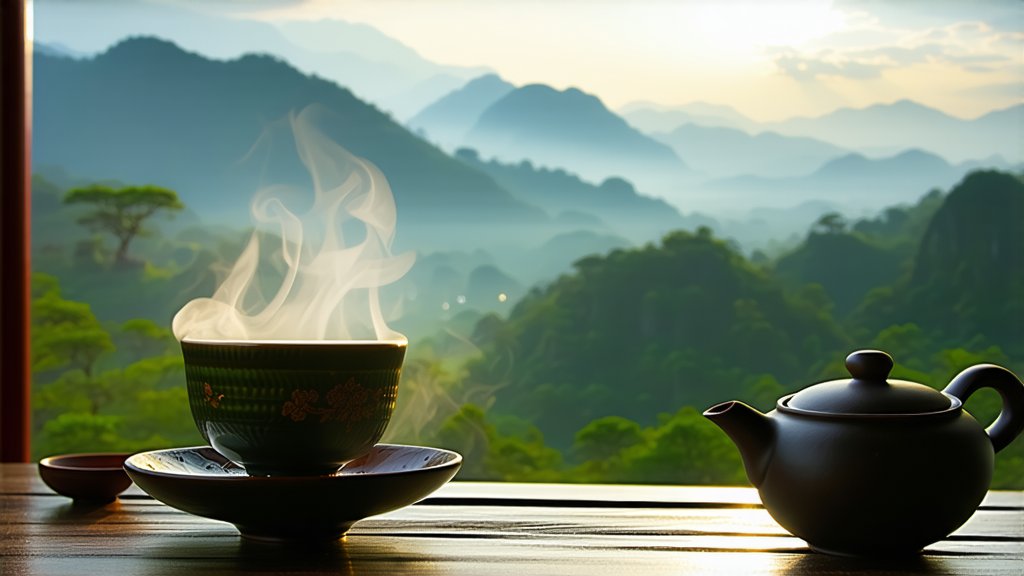
The world of tea is vast and diverse, but few varieties capture the imagination quite like Da Hong Pao (Big Red Robe) oolong tea. This exquisite tea, hailing from the picturesque Wuyi Mountains in Fujian Province, China, is not just a beverage; it's an experience steeped in history, tradition, and unparalleled flavor. Join us as we embark on a journey through the captivating realm of Da Hong Pao, exploring its historical roots, unique varieties, intricate production process, and the art of its appreciation.
Historical Tapestry
Da Hong Pao's story begins over four centuries ago during the Ming Dynasty, around 1500-1600 AD. According to legend, a poor scholar fell ill while en route to his imperial examinations. He was nursed back to health by a kind monk who brewed him a potion made from wild tea leaves found on the cliffs of the Wuyi Mountains. The scholar recovered, passed his exams with flying colors, and returned to find the monk, only to discover he had passed away. In honor of the monk, the scholar named the tea "Da Hong Pao," after the robe worn by high-ranking officials, symbolizing prosperity and good fortune.
This tale, though romanticized, underscores the deep cultural significance and reverence that surrounds Da Hong Pao. Over time, it became a prized commodity, enjoyed by emperors and commoners alike, and eventually gained international acclaim for its distinctive character and complexity.
Varieties of Da Hong Pao
While Da Hong Pao is often referred to as a single tea, it encompasses several distinct sub-varieties, each with its own unique terroir and flavor profile. These include:
-
Zheng Yan Cha: Grown in the core Wuyi Mountain area, these teas are considered the epitome of quality. They benefit from the unique mineral-rich soil and microclimate, resulting in complex flavors and a lingering finish.
-
Xing Village Da Hong Pao: Produced in Xingcun, this variety is known for its robust aroma and full-bodied taste, reflecting the region's slightly different growing conditions.
-
Wuyi Rou Gui: A close relative of Da Hong Pao, Rou Gui translates to "Cinnamon Cypress." It shares similar cultivation practices and offers a cinnamon-like spiciness, complemented by sweet undertones.
Each variety showcases the versatility of the oolong tea category, demonstrating how subtle differences in geography and processing can yield remarkably diverse flavors.
The Art of Crafting Da Hong Pao
The making of Da Hong Pao is a meticulous craft that requires both skill and patience. Here's an overview of its traditional production process:
-
Plucking: Only the youngest leaves and buds are handpicked, typically during the spring and autumn harvests when the weather conditions are ideal for optimal growth.
-
Withering: Freshly picked leaves undergo a slow withering process, either under sunlight or indoors, allowing them to lose moisture gradually while enhancing their natural fragrance.
-
Bruising: Leaves are gently tossed or rolled to break down cell walls, facilitating oxidation. This step varies in intensity based on desired oxidation levels.
-
Oxidation: Unlike green teas, which are minimally oxidized, oolong teas like Da Hong Pao undergo partial oxidation, striking a balance between freshness and richness. This stage can last anywhere from several hours to days.
-
Fixation: To halt oxidation, the leaves are quickly heated in a wok or oven, preserving their unique flavors and locking in their vibrant color.
-
Torrefaction: A final roasting step further refines the tea's flavor profile, imparting a toasty warmth that complements its inherent sweetness and floral notes.
-
Sorting and Packaging: After cooling, the leaves are meticulously sorted by grade and size before being packaged for sale.
This artisanal approach ensures that every cup of Da Hong Pao is a testament to the craftsmanship and dedication of its makers.
The Symphony of Taste: Appreciating Da Hong Pao
To truly appreciate Da Hong Pao, one must engage in the ritual of Gongfu Cha, a traditional Chinese tea ceremony that emphasizes mindfulness and precision. Here's a guide to savoring this exceptional tea:
-
Preparation: Use a Yixing clay teapot or a Gaiwan (a lidded bowl), as they enhance the tea's aroma and maintain its temperature. Rinse the vessel with hot water to warm it up.
-
Measurement: Take approximately 5 grams of Da Hong Pao per 150ml of water. Adjust according to personal preference and the number of infusions planned.
-
Water Temperature: Boil water to around 95°C (203°F). Let it cool for a minute before pouring over the leaves to avoid scalding them.
-
Infusion: Steep the first infusion for about 15 seconds, then discard this rinse to awaken the leaves. Subsequent infusions can range from 20-30 seconds each, gradually increasing to extract different flavor nuances.
-
Aroma & Flavor: Inhale deeply before each sip to appreciate the tea's evolving fragrance—floral, fruity, and roasted notes intertwine harmoniously. Take small sips, rolling the liquid across your palate to fully experience its complexity.
-
Multiple Infusions: Da Hong Pao is renowned for its ability to be infused multiple times, each revealing new layers of flavor and aroma. Typically, 6-8 infusions are possible, with each offering a unique tasting experience.
By following these steps, you not only enjoy the tea but also connect with centuries-old traditions that celebrate the art of tea making and drinking.
Conclusion
Da Hong Pao stands as a shining example of China's rich tea heritage, embodying the perfect blend of nature's bounty and human ingenuity. From its storied past to its meticulous production and the meditative act of its consumption, it invites us to slow down, appreciate the finer things in life. Whether you're a seasoned tea connoisseur or a curious newcomer, the allure of Da Hong Pao promises an unforgettable voyage into the depths of oolong tea culture. So, next time you crave an adventure for your senses, why not embark on a journey with a cup of Da Hong Pao in hand?